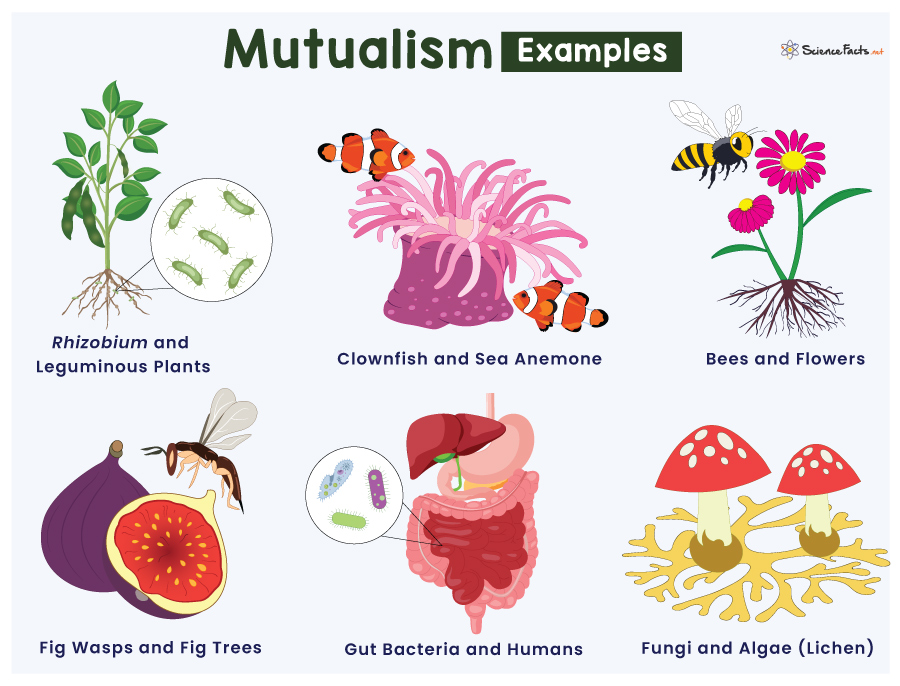The term mutualism was coined by Pierre-Joseph van Beneden from the Latin word mūtu(us), meaning “mutual” or “reciprocal”, and from the Greek word ismos, meaning “often directly”, to describe mutual interaction between species.
Types of Mutualism
Examples of Mutualism in Nature
While the relationship is complex, it can be of two types: obligate and facultative. In obligate mutualism, the partners depend entirely on each other for survival. In contrast, organisms that derive benefit from the relationship but can survive without the other are called facultative mutualism. Mutualism can be species-specific or diffuse. In species-specific mutualism, one partner is involved exclusively with the other. In contrast, in a diffuse mutualistic relationship, a partner has multiple interactions with different species. Some common examples of mutualism in nature are:
Clownfish and Sea Anemone
Sea anemones found attached to the surface of the coral reefs trap their prey with stinging cells called nematocysts located on their tentacles. Nematocysts release toxins in response to a small animal attaching to its tentacle. It paralyzes the animal allowing the anemone to bring its food close to its mouth for ingestion. However, clownfish secrete a substance in their mucus that prevents the firing of toxins by the nematocysts. Thus, the clownfish quickly swim between the tentacles of anemones in an environment secure from its potential predators. In this way, the clownfish benefit from their relationship with sea anemones. The anemone also gains as the bright-colored clownfish attracts other fishes looking for their food, which the anemone eats.
Oxpecker and Rhinoceros
Oxpeckers land on rhinos and eat ticks and other parasites that live on their skin. The oxpeckers obtain food from the animal, while the beasts get pest control. When in danger, the oxpeckers fly upward and scream a warning, which helps the other partner.
Gut Bacteria and Humans
Certain beneficial microorganisms, such as Escherichia coli, live in the intestine of humans and many other animals. The bacteria help food to digest taken by humans while deriving nutrients from the same food for itself.
Rhizobium and Leguminous Plants
Root nodules of leguminous plants like peas, beans, and clover are formed due to colonization of nitrogen-fixing microorganisms such as Rhizobium. Here, the plants give food and habitat to the microorganisms. At the same time, the bacteria fix atmospheric nitrogen to an organic form, which makes it easy for the plants to use.
Fungi and Algae (Lichen)
The interspecific association between fungi and algae is called the lichen. The fungi provide water and minerals to the algae, while the algae provide food to the fungi. Separating a partner from the other will result in the other partner’s death. Thus, lichen is an example of obligate mutualism.
Plants and Birds
The plants bear fruits that the birds feed on. In return, the birds help disperse the seeds when they excrete at a place far away from the source plant. It helps to reduce competition for growth in new plants and thus can grow in a healthy environment where they can quickly obtain food and sunlight.
Spider Crab and Algae
Spider crab lives in shallow areas of the ocean floor, and the algae live on the crabs’ backs. It helps crab to blend with the environment to evade predation. The algae get an excellent place to live, and the crab benefits from camouflaging. Other common examples of mutualistic relationships found in nature are between mesquite and cacti and between crabs and sea urchins.
Bees and Flower (Pollination)
Almost all pollination depicts a mutualistic relationship that has evolved over the years. Pollinating agents or pollinators such as bees, moths, butterflies, and birds visit the flower in search of nectar. Once they sit on the flower to collect the nectar, pollen grains stick to their body. When the pollinators visit another flower, they transfer the pollen to the stigma. This process, known as pollination, helps plants to reproduce by sexual means.
Wasps and Fig Trees (Reproduction)
As we know, pollination helps plants to reproduce sexually. A mutualistic relationship is also found to help animals in their reproduction. For example, the lifecycle of fig wasps and fig trees depends on each other. The queen wasp enters the fig through an opening in the base, losing her wings and antennae. Inside the fig, the wasp lays eggs and deposits the pollen, which she carried from another fig. In the process of doing so, she fertilizes the fig’s ovaries. Once she has deposited the egg, the queen dies and becomes a food source for the fig. After the eggs hatch, the males and females mate with each other. The females collect nectar, while the males dig through the flesh to create an exit path for the females. After escaping, the females visit another tree carrying the pollen with them, which helps to start a new reproduction cycle for both of them.
Mutualism, Commensalism, and Parasitism
Mutualism is a symbiotic association in which both organisms benefit. Commensalism is a symbiotic relationship where one organism benefits and the other is neither helped nor harmed. Parasitism is also a symbiotic relationship, where one of the partners benefits while the other is harmed.
